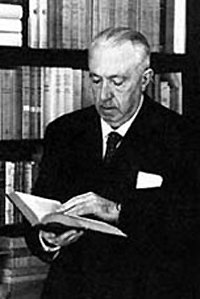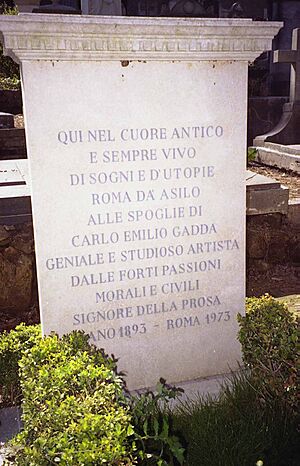Carlo Emilio Gadda facts for kids
Quick facts for kids
Carlo Emilio Gadda
|
|
|---|---|

Carlo Emilio Gadda in the 1960s
|
|
| Born | November 14, 1893 Milan, Italy |
| Died | May 21, 1973 (aged 79) Rome, Italy |
| Occupation | Writer |
| Nationality | Italian |
| Period | 1932–1973 |
| Genre | Fiction, essays, poetry |
| Literary movement | Modernism, Postmodernism |
| Notable awards | Bagutta Prize, Viareggio Prize |
Carlo Emilio Gadda (November 14, 1893 – May 21, 1973) was an Italian writer and poet. He was known for his unique writing style. He liked to play with the standard Italian language, adding words from different dialects, technical terms, and wordplay.
Biography
Gadda was an engineer from Milan. He had mixed feelings about his job, but his scientific background influenced his writing, making it very precise. Critics have compared his exact style to other writers with a science background. Gadda's writing often used styles like baroque (very detailed and complex), expressionism (showing strong emotions), and grotesque (mixing humor with something strange or scary).
Carlo Emilio Gadda was born in Milan in 1893. He always felt a strong connection to his hometown. Later in his life, he also lived in Florence and Rome. People sometimes called him Il gran Lombardo, which means 'The Great Lombard'. This nickname comes from an old poem by Dante Alighieri about someone from Lombardy who helped him.
Gadda's father died in 1909. This made things financially difficult for his family. However, his mother tried to keep up appearances, even though they had less money. These family struggles appear in his book La cognizione del dolore.
He studied in Milan at the Politecnico di Milano, a university for engineering. During his studies, he volunteered for World War I. He was a lieutenant in the Alpini corps, leading a machine-gun team. In October 1917, he was captured during the Battle of Caporetto. His brother was killed in a plane crash during the war, and this sad event is a big part of La cognizione del dolore. Gadda was a strong nationalist at the time, and he felt very humiliated by the months he spent as a prisoner of war in Germany.
After the war, Gadda graduated in 1920. He worked as an engineer until 1935, spending three years in Argentina. One of his lesser-known achievements was helping to build the Vatican Power Station. He used his experiences in Argentina for the setting of his book La Cognizione del Dolore.
In the 1940s, Gadda started to focus more on writing. This was during the time of fascism in Italy. Gadda was a pessimistic person, and his bitterness grew with age.
In his book Eros e Priapo (1945), Gadda looked at how Italian Fascism and the leader Benito Mussolini became popular in Italy. He described Fascism as a movement that appealed to the middle class. This book was not published until 1967 because some parts were considered too strong or offensive.
In 1946, a magazine published his crime novel Quer pasticciaccio brutto de via Merulana. This book was later translated into English as That Awful Mess on Via Merulana. It is famous for its experimental language, which uses many different Italian dialects. It is also unusual because it does not reveal who committed the crime at the end.
Gadda remained a bachelor throughout his life. His writing often challenged traditional middle-class values. He did this by using a mix of different languages, including dialects, academic terms, and technical words. This was interesting because Gadda himself came from a respectable, though struggling, background.
Gadda continued writing until he passed away in 1973. A very important literary expert who studied Gadda's work was Gianfranco Contini. In 2017, it was revealed that Gadda was nominated for the Nobel Prize for Literature in 1966.
Literary work
- La madonna dei filosofi (1931), translated into English as The Philosophers' Madonna
- Il castello di Udine (1934)
- Le meraviglie d'Italia (1939)
- Gli anni (1943)
- L'Adalgisa (1944, short stories)
- Il primo libro delle favole (1952, a collection of tales written in an old-fashioned style)
- Novelle dal ducato in fiamme (1953, short stories)
- I sogni e la folgore (1955)
- Giornale di guerra e di prigionia (1955), a diary about Gadda's time in World War I, including his military actions and his months as a prisoner in Austria.
- Quer pasticciaccio brutto de via Merulana (1946, 1957), translated into English as That Awful Mess on Via Merulana.
- I viaggi e la morte (1958)
- Verso la Certosa (1961)
- Accoppiamenti giudiziosi (1963)
- La cognizione del dolore (1963), translated into English as Acquainted with Grief or The Experience of Pain.
- I Luigi di Francia (1964), a summary of French history, told with the author's unique and sometimes critical viewpoint.
- Eros e Priapo (1967)
- La meccanica (1970)
- Novella seconda (1971)
- Meditazione milanese (1974)
- Le bizze del capitano in congedo (1981)
- Il palazzo degli ori (1983)
- Racconto italiano di ignoto del novecento (1983)
- Azoto e altri scritti di divulgazione scientifica (1986, a collection of scientific writings)
- Taccuino di Caporetto (1991)
- Opere (1988–93)
See also
 In Spanish: Carlo Emilio Gadda para niños
In Spanish: Carlo Emilio Gadda para niños


